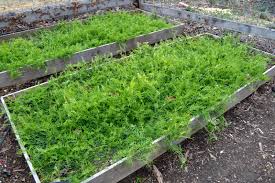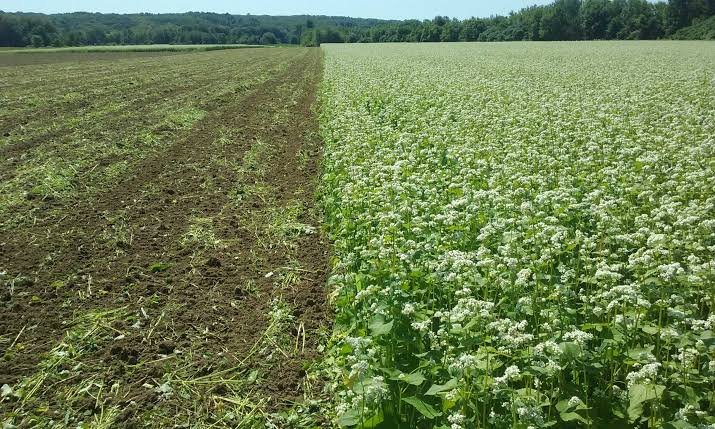Regarding the need to use cover crops, using cover crops means planting certain plants in agricultural fields during periods when the main crops are not actively growing.
These cover crops serve various purposes that contribute to the overall health and productivity of the soil. Farmers employ this practice for several reasons, and its benefits extend beyond the immediate growing season.
Cover crops play a crucial role in preventing soil erosion. When heavy rains or strong winds occur, bare soil is prone to washing away, leading to degradation. By planting cover crops, farmers create a protective cover that shields the soil from these erosive forces, helping to maintain its structure and fertility.
Moreover, the use of cover crops enhances soil fertility. Certain plants, such as legumes, have the ability to fix nitrogen from the air and convert it into a form that plants can use.
This natural nitrogen fixation process enriches the soil with this essential nutrient, reducing the need for synthetic fertilizers. As a result, farmers can promote sustainable farming practices and reduce their reliance on chemical inputs.
Another significant aspect of using cover crops is weed suppression. The dense foliage of cover crops competes with weeds for sunlight, water, and nutrients, inhibiting weed growth. This natural weed control method reduces the need for herbicides, contributing to a more eco-friendly and cost-effective farming approach.
The biodiversity introduced by cover crops also attracts beneficial insects and microorganisms to the soil. These organisms, such as earthworms and beneficial bacteria, contribute to the overall health of the soil ecosystem. Improved soil health, in turn, fosters better conditions for the growth of main crops when the planting season resumes.
Beyond soil health, cover crops assist in managing water resources effectively. The root systems of these plants help in water retention, preventing excessive runoff and promoting better infiltration. This is particularly beneficial in areas prone to drought, as cover crops contribute to maintaining soil moisture levels for longer periods.
Furthermore, using cover crops supports crop rotation strategies. Farmers can strategically select cover crops that complement the nutrient needs of their main crops, creating a balanced and sustainable cropping system. Crop rotation with cover crops helps break pest and disease cycles, reducing the reliance on chemical pesticides.
However, the practice of using cover crops is a multifaceted approach that brings numerous advantages to agriculture. From preventing soil erosion and enhancing fertility to weed suppression and water management, cover crops contribute to the overall sustainability and resilience of farming systems.
As farmers increasingly recognize these benefits, the adoption of cover cropping continues to grow, ushering in a more environmentally friendly and resilient era in agriculture.
Read Also: Recommended Methods of Selecting Snail Breeding Stock
How to Use Cover Crops

Cover crops are plants grown primarily to protect and enrich the soil. They offer numerous benefits for your garden or farm. Using cover crops is a straightforward and beneficial practice. Here’s a simple guide on how to make the most of cover crops:
1. Choose the Right Cover Crop: Select cover crops based on your specific needs. Common cover crops include legumes like clover and peas, grasses like rye and oats, and brassicas like radishes. Each type has unique advantages, such as fixing nitrogen, preventing erosion, or breaking up compacted soil.
2. Plan Planting Times: Timing is crucial. Plant cover crops during periods when your main crops are not in the ground. This could be after harvesting in the fall or early spring. This ensures that cover crops do not compete with your primary crops for nutrients and sunlight.
3. Prepare the Soil: Before planting cover crops, prepare the soil by removing debris and weeds. Loosen the top layer of soil to create a favorable environment for cover crop seeds to germinate.
4. Seed Application: Broadcast the cover crop seeds evenly over the designated area. You can use a seed spreader for larger areas. Lightly rake the soil to cover the seeds with a thin layer of soil. Press down gently to ensure good seed-to-soil contact.
5. Watering: After planting, water the area thoroughly to help the cover crop seeds establish. Adequate moisture is crucial for germination and early growth.
6. Monitor Growth: Keep an eye on the cover crop’s development. Most cover crops grow relatively quickly. If you notice excessive growth, mow or cut them down before they set seeds to prevent self-seeding.
7. Nitrogen Fixation (for Legumes): If you’ve chosen leguminous cover crops like clover or vetch, they’ll contribute nitrogen to the soil. Allow these plants to grow for a longer period to maximize nitrogen fixation.
8. Erosion Control: Cover crops with strong root systems, such as grasses, help prevent soil erosion. This is especially important on slopes or in areas prone to heavy rainfall.
9. Green Manure: Incorporate cover crops into the soil before they reach maturity to enhance organic matter. This process, known as green manure, adds valuable nutrients to the soil, promoting overall soil health.
10. Crop Rotation: Integrate cover crops into your crop rotation plan. This helps break pest and disease cycles and improves soil structure over time.
11. Chop and Drop: When the cover crops have served their purpose, chop them down and leave the plant material on the soil surface. This acts as a natural mulch, protecting the soil and providing additional organic matter.
12. Prepare for Main Crops: Once the cover crops have been incorporated or left as mulch, you’re ready to plant your main crops. The enriched soil and improved structure will contribute to healthier plant growth.
Using cover crops is a simple yet effective way to enhance your garden or farm. Whether you’re aiming to improve soil fertility, control weeds, or prevent erosion, incorporating cover crops into your agricultural practices can lead to more sustainable and productive outcomes.
Read Also: Best Snail Rearing Stocking Density for Best Results
The Advantages of Using Cover Crops

Cover crops offer various advantages for your garden or farm, contributing to both soil health and overall agricultural sustainability. Here are some key advantages:
1. Soil Fertility Improvement: Cover crops, especially legumes like clover and peas, have the ability to fix nitrogen from the air into the soil. This natural nitrogen enrichment enhances soil fertility, providing essential nutrients for subsequent crops.
2. Weed Suppression: The dense growth of cover crops helps smother and outcompete weeds, reducing the need for herbicides. This natural weed suppression not only saves time and effort but also promotes a healthier, weed-free growing environment.
3. Erosion Prevention: Cover crops with robust root systems, such as grasses, help bind soil particles together, preventing erosion. This is crucial, especially on sloping terrain or areas prone to heavy rainfall, where soil erosion can be a significant challenge.
4. Water Conservation: The cover crop canopy provides shade and reduces evaporation from the soil surface. This helps conserve water, making cover crops valuable in regions where water availability is a concern.
5. Disease and Pest Control: Cover crops can disrupt pest and disease cycles. They act as a buffer zone, diverting pests away from main crops. Additionally, certain cover crops release compounds that inhibit the growth of specific pathogens, contributing to overall disease control.
6. Improved Soil Structure: The extensive root systems of cover crops help break up compacted soil, improving its structure and aeration. This allows water to penetrate more easily and enhances the movement of nutrients, fostering a healthier soil environment.
7. Biodiversity Enhancement: Introducing a variety of cover crops can increase the diversity of plant species in your agricultural system. This diversity supports a range of beneficial organisms, including pollinators and beneficial insects, contributing to a more balanced ecosystem.
8. Climate Resilience: Cover crops can play a role in mitigating the impacts of climate change. They contribute to carbon sequestration in the soil, helping reduce greenhouse gas emissions. Additionally, the improved soil structure and water retention properties contribute to climate-resilient agriculture.
9. Green Manure: Cover crops, when incorporated into the soil before maturity, act as green manure. As they decompose, they add organic matter to the soil, enhancing its nutrient content and overall health.
10. Cost Savings: By reducing the need for synthetic fertilizers, herbicides, and other external inputs, cover crops can lead to cost savings in the long run. They offer a natural and sustainable way to improve soil quality and crop productivity.
Incorporating cover crops into your agricultural practices can be a valuable strategy for promoting sustainable and regenerative farming. The numerous benefits they provide contribute to healthier soils, increased crop yields, and a more resilient and environmentally friendly farming system.
Read Also: Role of a Montessori Teacher and Critique of the Montessori Method

